Quack this mystery: can you tell which
timeline came first?
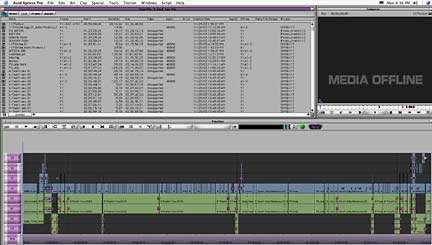
Typical Avid timeline.
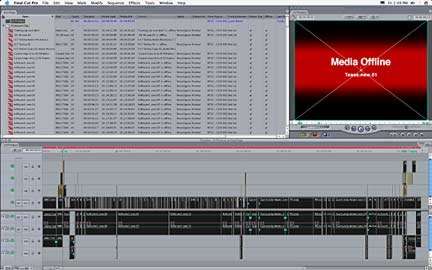
Typical FCP timeline-- same show.
What "The Duck" can do for
those users transferring Avid offline sequences to FCP for finishing
-- or just to continue editing-- is very impressive indeed, and
what Duck can do for users transferring an offline from FCP to
Avid for onlining is also convenient, although not yet as transparent
as Avid offline to Avid online. The savings in time, however,
are significant and if you expect to do more than a few sequence
transfers a year, purchasing one or both Pro plugins will pay
off handsomely. Going either direction, your best option is to
recapture the underlying media in your chosen native NLE codec,
which completes the process.
Taking Wing
Let's fly through this product and first
explore an FCP-to-Avid edited sequence transfer using the Duck's
Pro Export. (Both Import and Export are designed for FCP 4.1
or later.) I did my tests in Jaguar 10.2.6. The plugins are easily
installed and activated for your specific machine via Automatic
Duck's automatic 24/7 web registration.
In FCP assume we've done an offline with
several video layers, some composited titles and filters, image
effects, freeze frames, photo or headline moves, and custom transitions.
Let's also assume you have a keyframed audio design. You load
the desired edited sequence into your timeline, or select it
in your FCP bin, and then invoke the Automatic Duck Pro Export
plug in from File>Export, and away it flies.
Automatic Duck Pro Export FCP reads all of these timeline elements differently.
Opening the Avid system, you simply choose Import, set the mask
for OMF files, locate your FCP Export and bring in your FCP Export
OMF file.
You'll see the layers of video and audio
clips-- even subclips!-- have come across seamlessly, ready for
online recapture using your choice of Avid codec. That alone
is spectacular; you've just wiped out the need for EDL's, batch
lists, ALE translation, etc. Just Export and Duck!
To repeat, transfer from FCP to Avid
requires recapturing from your sources using an Avid codec. Going
the other way, the manual says you have a choice which allows
you to either re-capture, or actually link to the Avid media
and play it inside FCP- without rendering! I did not test this.
It comes with potential limitations due to difference in media
file structures, so capture using a native FCP preset is recommended--
especially if you're finishing on FCP and the Avid media is an
offline format. Still, a neat trick.
My tests did not include re-capture of
media, either, but an examination of equivalent clips showed
me the timecode was frame-identical and of proper format.
Minor Flaps
For now, anything done in Final Cut Pro
to change the look of your image: keyframed scale, position,
rotation changes, color corrections, filters, etc. are all considered
effects by the Duck Pro Export. Effects details can certainly
be described in the exported OMF file, but for now, not in a
way that Avid systems will accept. Your effects will have to
be re-built in your Avid system.
Since a main application for Pro Export
will be to move an FCP offline to Avid for finishing, this isn't
a major calamity. Finishing editors like to bring their own judgement
to color legalizing and correction, and often expect to completely
redesign motion effects such as photo zooms, special transitions,
posterizations as well, after reviewing the reference video.
(Alright, they may not be expecting it!) What's nice is, all
these elements are clearly and accurately represented as placeholder
clips in the Avid timeline.
All FCP transitions-- wipes, pushes,
peels-- will be translated to dissolves in the Avid; all special
transitions must be rebuilt. If your transition is 10 frames
in FCP, lo and behold, the representative dissolve is 10 frames
in Avid. If all you use in a show is dissolves, that job is done.
Transition, effect and clip durations
are observed. Constant-speed-changed FCP clips translate to Avid
speed-changed clips. Variable time remapping is not translated.
Freeze frames are translated.
Titles such as Boris Calligraphy-generated
clips from FCP must be recreated, unless you render them out
separately as Quicktimes using the appropriate Avid QuickTime
codec and then import them-- a timesaving workaround. (Of course,
they're no longer internally editable.) Whether you generate
for import or choose to recreate from scratch using Avid title
tool, the Duck is still helpful. Titles are duration effects
as opposed to "parameter" effects like color correction,
and they are accurately represented in Avid as plaeholder clips,
at the right timeline point and of the right duration. Placeholders
in the Avid will carry whatever name you give each title clip
in FCP, so name them first to reflect their contents in FCP's
Logging Info pane (Command-9). In Avid you recreate the title
and simply replace each placeholder with an overwrite edit.
Photoshop and PICT files and imported
elements like QuickTime movies are represented int he Avid timeline
as placeholders, with accurate timecode from your FCP sequence.
Just reimport to Avid and replace with overwrites. MoCo moves
must be rebuilt using Avid-specific tools like Resize and Pan
& Zoom.
A Loud Quack

FCP audio levels and keyframed section

Translated into Avid.
Here's an ear-opener: with Pro Export
FCP, audio clips will come across into Avid with identical keyframed
level changes! If you attempt to export more FCP tracks than
your Avid model can handle, those layers will be locked.
Currently, audio pan changes are not
translated, but this is largely a non-issue since your finishing
workflow will likely involve a separate sound sweetening facility
which will bounce its mix right to your Avid finisher for mastering
to tape. But it's nice to have a reference track which mirrors
the FCP scratch balance until it's replaced-- you can rush finished
picture lock out to execs, close captioning department, or sponsors
for review even while the mixing engineer is in the middle of
sweetening, should the schedule require it! Who knows? The Duck
opens up such possibilities.
The new Duck translates FCP Nests. Read
that again! Upon Avid OMF import, each is translated into an
Avid Submaster effect, the nearest relative. The only limitation
is an oddball caveat: you cannot establish a nest, then make
a cut to shorten it, and then export it-- Duck Export won't understand
such cuts in the nest shell-- it's looking at the original nest
and the info inside only. Trim to taste after Avid import.
If you have sliced into your nest
at one or more points, you must export your main FCP sequence,
then go back and export each nest fragment, one at a time, from
cut to nest cut. They each retain their location in sequence
timecode, and can be edited into the main sequence once in the
Avid timeline, where, again, placeholder regions have been established,
to be filled by the "mini-Nests." But for greatest
time savings, do a picture lock on all nest components and then
export the solid nest.
Avid-compatible OMF files exported from
FCP have been tested with Avid Symphony, Media Composer, Xpress
and Xpress DV in NTSC (30i) and PAL (25i). I tested various OMF
Duck Exports from FCP 4.1 to Avid XpressDVPro 4.1.1 on my own
system. It delivers.
If you're still grumbling how it seems
so many elements still have to be rebuilt, take that memory pill
and remember how it used to be done, if at all, before the miracle
mallard arrived. Only the Duck has quacked this problem, with
history supporting composition transfer paths such as Avid to
After Effects, After Effects to Avid, FCP to After Effects and
now, finally, Avid to FCP and the reverse. One excellent FCP-to-Avid
strategy is to offline cuts-only in FCP-- no matter how elaborate
the track layering-- and then Pro-Export for effects and finishing
together. (Online editors don't have enough to do, right?)
Saved by the Bill
I'm the kind of guy who carefully excavates
a slice of cake to leave the frosting standing for last.
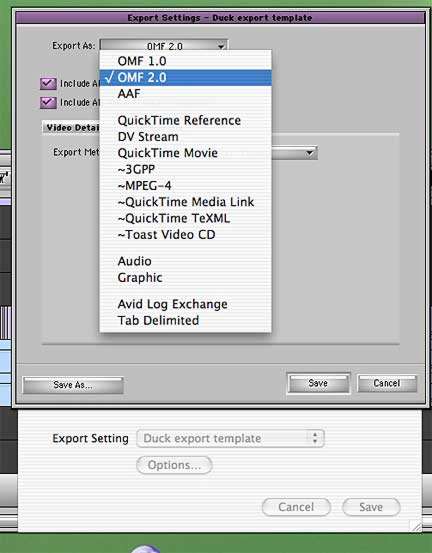
On the Avid side, just export a sequence as OMF 2.0, Composition
only. Here I've named and saved the Avid Export settings as a
"Duck export template."
When it comes to importing a timeline
from Avid to FCP: wow! Much different story. Automatic Duck
Pro Import FCP is a powerful plug-in which reads in OMF (and
soon AAF) metafile information and converts it to XML to be interpreted
by FCP 4.1. The result is rich. Apple and the Final Cut Pro team
have nailed it again, supporting the XML standard. When you apply
the Duck Pro Import, you see it in action.
First you must recover from an accurate
and spooky clone of your Avid sequence in the FCP timeline--
in seconds (for a good example, compare the timelines at top
of this article). Then you'll discover not only does the Duck
accurately rebuild the clip structure of the Avid sequence in
FCP, in all the proper layers of video and audio, but it also
translates via XML many Avid effects into their nearest literal
FCP equivalents-- no rebuilding required. The Duck translates
almost every Avid element except complete Group Clips.
Group Clips are those special structures
created in Avid from two or more synched layers of video, specifically
for Avid Multicam "live" switching between angles.
I asked Automatic Duck CEO Wes Plate how Group Clips are handled
in this release.
"When we import Avid Group Clips
into FCP, we detect which clip from
the Group was "selected" and that is the clip you get
in the FCP timeline.
"Alternate" clips from the group... are not translated."
Only temporary, I suspect.
An awful lot of timeline data does come
over. For instance, an Avid Superimpose effect becomes an FCP
opacity value. Motion effects such as zooms, resizes, PIP, many
other traditional Avid motion effects are now translated and
require only tweak adjustment, if any. As in Export, freeze frames
are supported.
|

Avid submaster- top two title clips...
|

...Import as FCP Nests
|
Avid Submaster effects cross over as--
you guessed it-- placeholder Nests! Often Avid editors will combine,
for instance, a separate wipe-able title background band and
on the track above it, the title itself, for a lower third "identity
assembly", which is then combined into a Submaster. In FCP,
this assembly is a two-track nest, which precisely guides the
recreation and placement of each component to the exact frame.
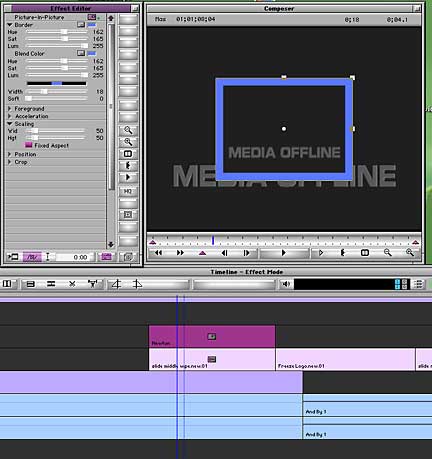
Avid Picture-in-Picture effect - note effect settings.
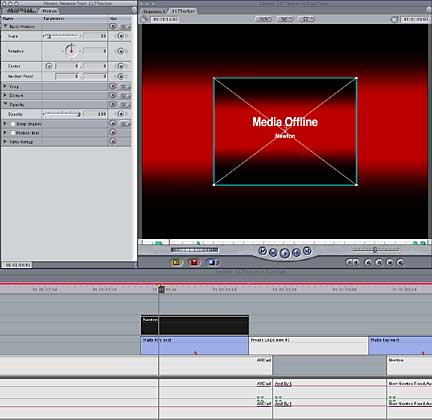
Translated into FCP-- note effect settings. (Yes, the Viewer's
Motion Effects pane is scaled to look like Avid's Effect Editor,
just for fun.)
Wes explains the current performance
imbalance between Export and Import.
"Avid effects like PIP and Resize
are not public, their representation
in OMF is encoded, making it impossible to write by third parties.
So we cannot create these kinds of effects in OMF, but we did
spend
some time to figure out how to read some key Avid effects like
PIP,
Superimpose and Resize. When we write a sequence into FCP via
their
new XML interchange, we have no restrictions, so we can write
whatever
we can support. This is why we can recreate more effects in FCP
than
we can send to Avid systems."
A Lighter Bill, But Still...
As a reality check: even in the best
case with the most unsullied translation of items from one environ
to another, no matter which way you go, allow extra tweak
time. Beyond redidging in the new environment, rebuilding
effects, keyframe animation, and titles from scratch always take
time. The difference in data rates alone, between offline and
online, cause significant variance in render times, and is unavoidable
with or without the Duck. But most users agree, to have such
tasks laid out before you with partial translations and accurate
placeholders is pretty huge.
Migratory Patterns
Where did the idea come from? Where is
it going? Why the strange name?
"At the end of 1998, beginning
of 1999 I was cutting a
regional commercial for the Philadelphia-area Chrysler
dealers, says Wes. "The designer on the spot was my friend
Justin Leibow, who now is the Creative Director at Fuel
in Santa Monica.
"During this time Justin and
I (along with other Seattle-ites we worked
with) were experimenting a great deal with ways to integrate
Avid editorial
with After Effects as a compositing/design/finishing tool. I
would cut pieces
both horizontally and vertically, then I would convert my edit
into an
After Effects project for him to take over and finish. This conversion
step
was always the annoying step, because it took so much time to
rebuild."
His early efforts to automate the process
are documented at www.wesplate.com/helpful/avid_to_ae/index.html.
Wes adds, "Those who are new to AE might enjoy seeing the
After Effects 3.1 screenshots."
In the mid 90's Avid Technology pioneered
and promoted the Open Media Framework as a bridge between applications
such as nonlinear editors and audio tools, which was adopted
by, among other toolmakers, DigiDesign, now a part of Avid, to
make audio transfers to ProTools® and back much easier. Apple
implements audio file OMF export natively in FCP (since version
2.0) for the same reason.
"Back in that same time period,
I got quite familiar with the OMF file format
as I would frequently send my edits' audio off to mix via the
format. I realized
that in the potential of OMF was the possibility of sending an
Avid edit to After
Effects. But AE couldn't read OMF. Problem."
Edwin Land used to tell his Polaroid
scientists, "The solution is in the room." Wes turned
to a close resource.
"Turns out my Dad, Harry, is
a wicked smart programmer. I approached
him with the idea that I was not alone in needing the ability
to effectively
integrate Avid and AE. After a VERY long time sitting on the
idea, we
started toying with it seriously in the summer of 2000, and by
October
2000 it was full-time, full-on, development-central.By spring
of 2001 we
had Automatic Composition Import 1.0 out the door."
So why did the Duckmaster name the product
"Automatic Duck?" During early development, Wes came
across the best-known work of French engineer/inventor Jaques
de Vaucanson, who in 1739, during an "automata" craze,
invented a mechanical duck which was a crowd-pleaser. It was
reportedly as amazing as Wes' products. It not only quacked,
swam, flapped its wings-- each made of over 400 parts-- it also
"ate" and "excreted"-- a useful analogy.
"The Final Cut community was
wise to the power we were
unleashing, and it wasn't long before we were getting requests
for a FCP-to-AE translator. In February of 2002 it was out."
As Final Cut Pro began showing up as
an affordable offline tool at post houses and TV stations, more
and more users clamored for efficient transfer protocols. While
accurate to the frame, using an edit decision list (EDL) limits
export to 1 video track at a time, plus one key or title layer.
For those cutting multilayer compositions in FCP, it was an unwieldy
workaround, and Wes knew it.
"The next project was to create
"Avid® Compatible" OMF® files
from FCP, to help break the EDL barrier. FCP offline, Avid online,
done more effectively than EDLs could do. Now we can also import
OMF into Final Cut Pro; you can imagine that this has been widely-requested."
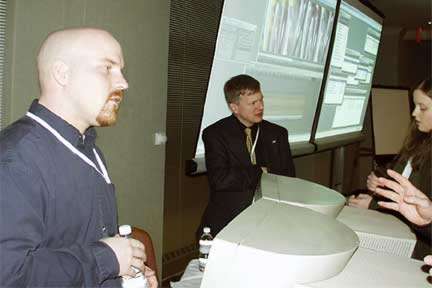
Automatic Duck CEO Wes Plate (L) demos at many popular digital
video events.
Automatic Duck today continues to fly
as a closely held business.
"Harry is still the lead engineer.
Over the last year we've benefited
from the contract expertise of four others, two of which are
still with us.
My wife Jessie handles all the order processing now,
so yes, we've grown. The work doesn't get any easier!"
But the products keep getting more powerful,
more capable, and could gradually erase the separate worlds of
Avid and FCP, to the benefit of both camps.
Moving forward two and a half centuries
from Vaucanson's mechanical miracle to Wes Plate's Automatic
Duck, producers, editors and post supervisors now have meaningful
NLE workflow choices with less hassle. To summarize:
- FCP to any format Avid finish (AD's
Pro Export FCP)
- Avid to any format Avid finish (direct)
- Avid to any format FCP finish (AD's
Pro Import FCP)
- FCP to any format FCP finish (direct).
"What started as a specific fix
to a specific need has grown," says Wes,
"because it turns out that in the real world users need
to be flexible. The
need to start a job in FCP and finish it in an Avid. Or pre-vis
in Xpress DV
and composite in After Effects. The number of workflow combinations
is growing
every day."
There's nothing daffy about choice.
Get quacking!
copyright©Loren S Miller
2003
This article is dedicated to the memory
of Ralph
Fairweather.
When not perseverating over nest arrangements
in his timelines, prizewinning editor Loren
S. Miller evangelizes the keyboard with his KeyGuide™
products at the LAFCPUG
Store and at www.neotrondesign.com
and also reports on various Macintosh media-creation events and
products. Special thanks to Dave Allen, Mark Steele and Harlan
Reiniger of WGBH-TV, PBS Boston, for assistance in preparing
this article.